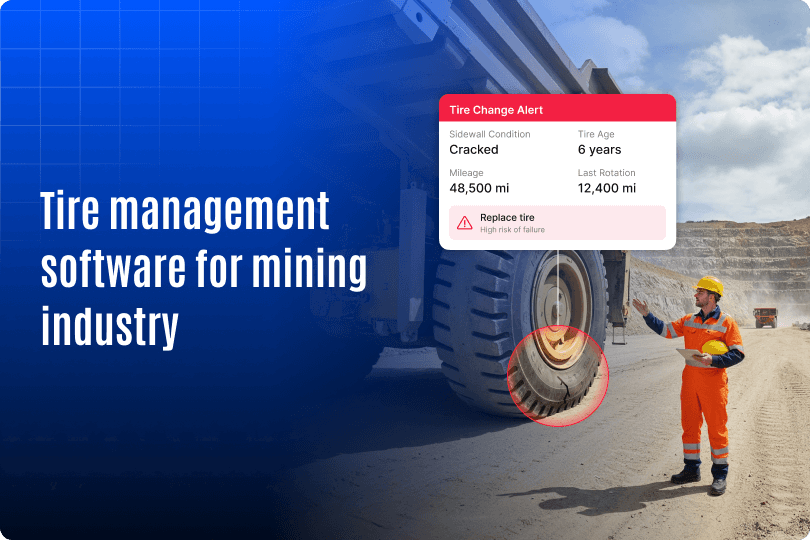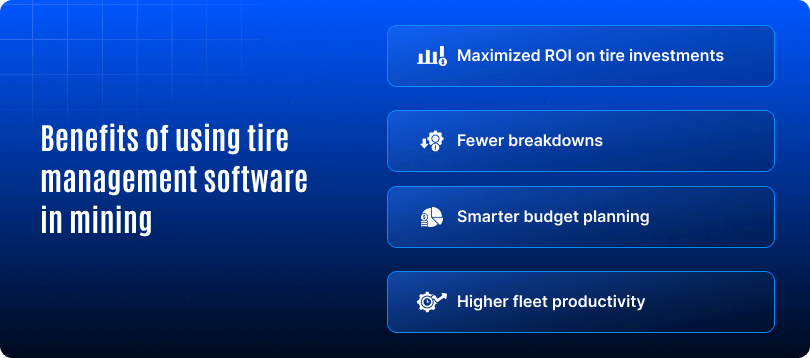Tire Management Software for Mining Industry

In the mining industry, fleets consist of many types of vehicles, such as haul trucks, loaders, and other heavy machines. These vehicles carry huge loads across rocky, uneven terrains and harsh environments, putting extreme stress on tires. This makes tire management software for mining industry fleets essential for ensuring tire reliability under such harsh conditions
And here’s the reality: a haul truck carries its weight on multiple high-value tires, each demanding constant care. This makes tire maintenance one of the most costly and difficult parts of mining operations.
This solution helps enterprises transform this challenge into a growth opportunity. By reducing downtime and lowering unnecessary costs it creates safer and more efficient operations. At the same time, it strengthens overall business performance. Fleet managers gain better control over costs, smoother operations, and confidence that their equipment will stay productive under pressure.
In this blog, we’ll explore tire lifecycle, real-time monitoring, and predictive insights, helping fleets take control of tire health. The result is lower costs, improved uptime, and turning tires from a constant expense into a managed business asset.
What is tire management software?
Tire management software is a digital tool that helps fleets monitor, maintain, and manage their tires. It keeps track of every tire from installation to disposal, records inspections, schedules maintenance, and provides alerts when problems arise. Replacing manual logs with organized data helps fleets reduce costs, improve safety, and extend tire life.
How mining operations push tires to the limit
1. Harsh terrains
Mining trucks run over sharp rocks, loose stone, and uneven ground, which wear tires faster and increase the risk of failure.
2. Heavy loads
Haul trucks carry massive weights, putting constant stress on tires, which shortens their lifespan and leads to early replacements.
3. Safety risks
Tire failures in mining can be dangerous, putting drivers, equipment, and site safety at risk.
4. Impact on operations
When a tire fails, the truck stops, and production slows. Even brief delays can affect overall output and fleet performance.
5. High replacement costs
Tires are expensive, often costing tens of thousands of dollars each. Frequent replacements make operating costs rise quickly.
Key functions of tire management software for mining industry
- Tire lifecycle tracking – Keep track of each tire from installation to disposal to maximize return on investment.
- Real-time monitoring – Use sensor data to check tire pressure, temperature, and wear instantly.
- Predictive maintenance – Utilize analytics to forecast when a tire is likely to fail and schedule maintenance in advance.
- Inspection and logging – Let field teams log tire checks through mobile apps for accurate records.
- Centralized dashboards – Get a clear overview of tire performance and costs across the entire fleet.
- Alerts and notifications – Receive instant alerts for unusual conditions to minimize downtime risk.
- Inventory management – Manage tire stock and purchasing to control costs and avoid shortages.
Together, these benefits create measurable ROI by lowering operating expenses and increasing fleet efficiency.
Investing in tire management software that grows with your mining operations
Besides, Mining fleets don’t stay the same; they expand, move across sites, and adopt new technologies. The right tire management software isn’t just a tool for today; it’s a system that adapts as operations evolve.
- Proven cost savings – Extend tire life and reduce replacements as your fleet grows.
- Operational continuity – Predict failures so trucks stay productive, even as operations scale.
- Scalability across sites – Manage fleets in multiple locations through a single connected platform.
- Safety and compliance – Detect risks early and stay prepared for changing regulations.
- Strategic insights – Use tire performance data to make smarter budget and procurement decisions.
Emerging future trends in mining tire management
- Predictive intelligence – Tire management is shifting from fixing problems after they occur to planning before they happen. With predictive analytics, fleets can know when a tire is likely to fail and schedule replacements in advance.
- Smarter sensors – Future sensors won’t just track tire pressure. They will also monitor heat, load, and road conditions, providing managers with a comprehensive understanding of how mine environments impact tire performance.
- Sustainability goals – Mining companies are under pressure to reduce waste and meet ESG standards. Extending tire lifespans through retreading and recycling can help save money while supporting sustainability efforts.
- Autonomous fleet readiness – However, as self-driving haul trucks become more common, tire monitoring must keep up. Automated alerts and self-diagnosing systems will ensure safety even without constant human checks.
- Cloud access across sites – Besides, mining often happens in multiple locations. Cloud-based tire management allows teams on-site and at head offices to access the same real-time data for quicker decisions.
The final thought
Tires are some of the most valuable but also most fragile parts of mining fleets, which is why many companies now depend on tire management software for mining industry operations to track performance, cut costs, improve safety, and extend tire life. As mining grows, smart management will remain vital for reliability, compliance, and long-term success.





